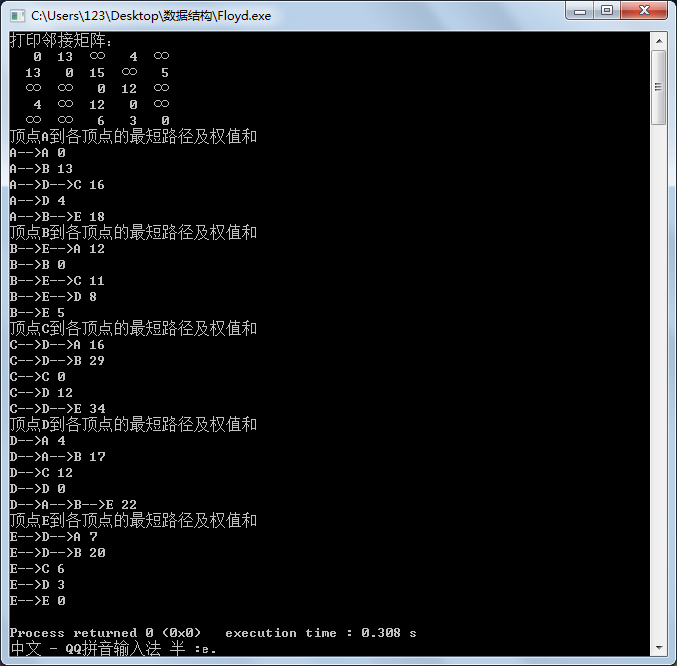Floyd算法<伪代码>:
1.初始化权值数组,路径字串
2.依次添加各顶点
2.1判断是否存在经由所添顶点产生的最小路径
2.1.1更新权值数组和路径字串组
源码:
#include<iostream>
#include<iomanip>//控制格式#include<string>
#define INF 0x3f3f3f3f//定义无穷大
using namespace std;
#define vertexNum 5//源点数
int G[vertexNum][vertexNum];//邻接矩阵
string vertex[]={"A","B","C","D","E"};//源点字符串组
void CreateMGraph()
{
for(int i=0;i<vertexNum;i++)
for(int j=0;j<vertexNum;j++)
{
if(i==j) G[i][j]=0;
else G[i][j]=INF;
}
G[0][1]=13;G[0][3]=4;
G[1][0]=13;G[1][2]=15;G[1][4]=5;
G[2][3]=12;
G[3][0]=4;G[3][2]=12;
G[4][2]=6;G[4][3]=3;
}
void Floyd()
{
int dist[vertexNum][vertexNum],i,k,j;//dist为权值存储数组
string path[vertexNum][vertexNum];
//cout<<"初始权值数组和路径字符串数组:"<<endl;
for(i=0;i<vertexNum;i++)
for(j=0;j<vertexNum;j++)
{
dist[i][j]=G[i][j];
path[i][j]=vertex[i]+"-->"+vertex[j];
/* cout<<path[i][j]<<" ";
if(dist[i][j]!=INF) cout<<dist[i][j]<<endl;
else cout<<"∞"<<endl;*/
}
for(k=0;k<vertexNum;k++)
for(i=0;i<vertexNum;i++)
for(j=0;j<vertexNum;j++)
{
if((dist[i][k]+dist[k][j]<dist[i][j])&&(dist[i][k]!=INF)&&(dist[k][j]!=INF)&&(i!=j))
{
dist[i][j]=dist[i][k]+dist[k][j];
path[i][j]=path[i][k]+"-->"+vertex[j];
}
}
for(i=0;i<vertexNum;i++)
{
cout<<"顶点"<<vertex[i]<<"到各顶点的最短路径及权值和"<<endl;
for(j=0;j<vertexNum;j++)
{
cout<<path[i][j]<<" ";
if(dist[i][j]!=INF) cout<<dist[i][j]<<endl;
else cout<<"∞"<<endl;
}
}
}
int main()
{
CreateMGraph();//创建邻接矩阵
cout<<"打印邻接矩阵:"<<endl;
for(int i=0;i<vertexNum;i++)
for(int j=0;j<vertexNum;j++)
{
if(G[i][j]==INF) cout<<setw(4)<<"∞";
else cout<<setw(4)<<G[i][j];
if(j==vertexNum-1) cout<<endl;
}
Floyd();
return 0;
}
截图:
